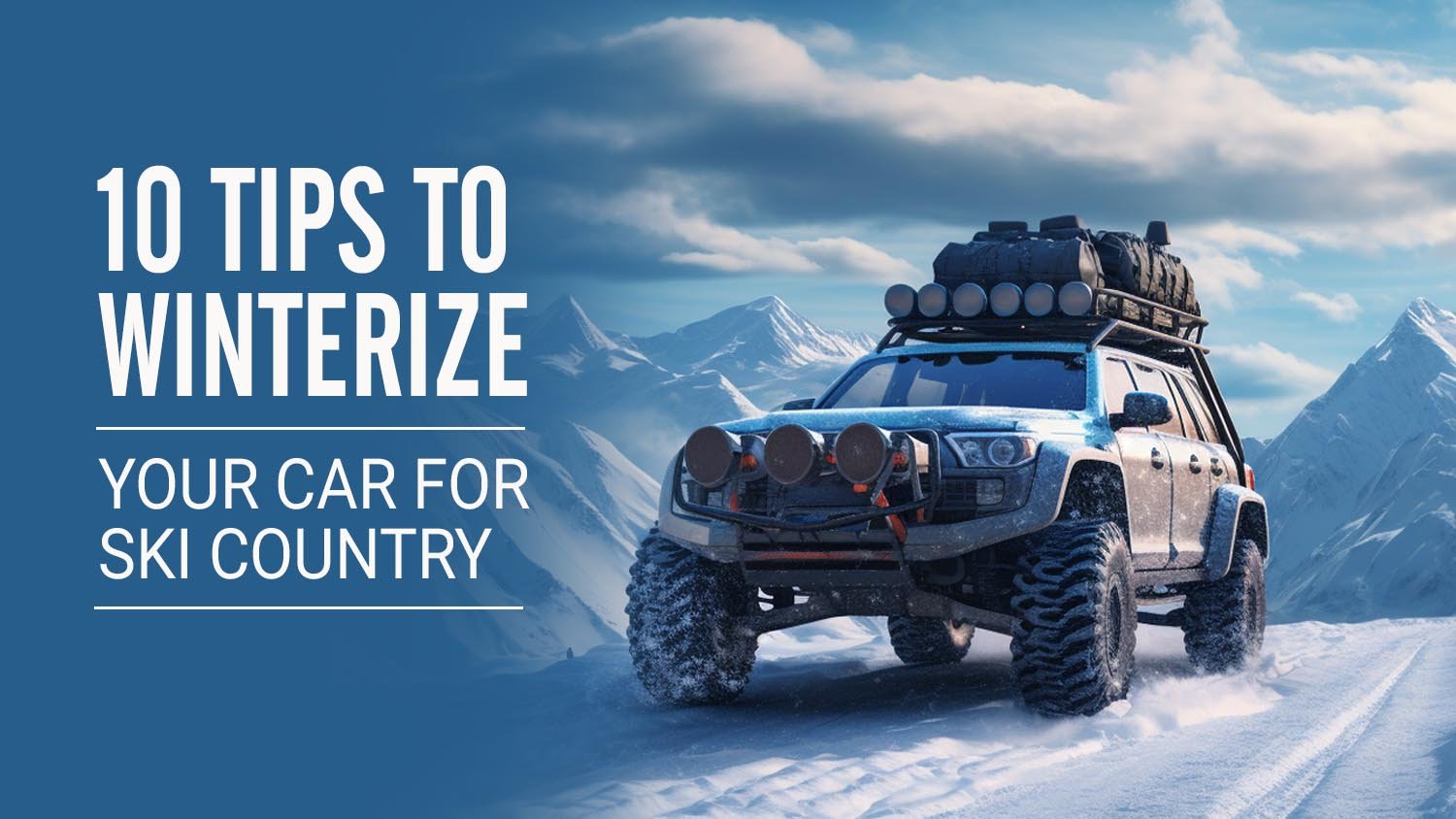10 Tips to Winterize Your Car for Ski Country
Winter is here, and if you're an avid skier, you're probably counting down the days until your next trip to the slopes. While planning for skiing adventures, it's essential to ensure your vehicle is properly winterized. Winter driving conditions can be challenging, so taking the necessary steps to prepare your car is crucial for safety and peace of mind. In this blog post, we'll walk you through the process of winterizing your car for your upcoming ski trips.
1. Check Your Tires
Your tires are your car's primary point of contact with the road, making them a top priority when winterizing your vehicle. Consider the following:
Snow Tires: If you live in an area with heavy snowfall, invest in a set of snow tires. These tires are designed to provide better traction in snow and ice, ensuring a safer drive to the ski resort.
Tire Pressure: Cold weather can cause your tire pressure to drop, which can affect your vehicle's handling. Regularly check and maintain the recommended tire pressure levels. Even if your tires are new or in good condition, you may still want to check their pressure after the first cold night. Fluctuations in temperature can cause tire pressure to vary by 1-10 psi per 10ºC. If you need help checking the tire pressure or putting air into your vehicle, follow these steps. You may also want to check the tire pressure on your spare just in case.
Tread Depth: Ensure that your tires have sufficient tread depth to provide traction. If they are worn down, it's time to replace them.
Snow Chains: Depending on your destination and local regulations, you may need tire chains or snow traction devices. Check the requirements for your route and carry these items in your car if necessary. Remember to get snow chains that fit your vehicle.
2. Stock an Emergency Kit in Your Car
When it comes to stocking an emergency kit, it may be better to be over-prepared. Having essentials like water and a blanket could be important if you become stranded during a snowstorm. These supplies may also come in handy if you spot another motorist in need of assistance.
Here are some useful items to include in your emergency kit:
Power Bank (fully charged) for your phone
Blanket
Clothing layers
First aid kit
Flashlight with extra batteries
Flares or emergency light sticks
Jumper cables
Small shovel
Non-perishable food items (high protein and energy bars)
Water bottles
Tire pressure gauge
Winter coats and gear (hats, gloves, extra shoes & socks), and possibly a small sleeping bag
Kitty litter for traction
Snow brush and snow scraper - Get an extra scraper as they can break.
For those who already have a winter car emergency kit in their vehicle, make sure you do an annual check of items to ensure they are in good condition and working order – remember, food expires, and batteries don’t hold their charge forever. Also, if you do find yourself stuck in the snow, don’t run your vehicle without first ensuring the tailpipe and up to three feet behind your vehicle are free of snow; this, along with opening your windows, will prevent deadly carbon monoxide from building up inside the automobile.
3. Replace Your Wiper Blades
Old and worn wiper blades can be a problem when driving in the winter. Instead of clearing the precipitation from your windshield, ineffective rubber stripping could make it harder to see.
If you haven’t replaced your wiper blades in a while, give them a thorough examination. Check to see that the metal arms are straight, and the rubber isn’t hard or worn down. If you determine that they need to be replaced, follow these instructions on changing wiper blades before winter starts.
4. Inspect Your Battery
Freezing temperatures can be cruel to your engine, especially the battery. And unlike other parts of your vehicle, batteries may not give a warning before they stop working.
To ensure your battery is ready for winter, try this quick checklist:
Examine the cables for cracks and breaks.
Make sure the terminals fit tightly.
Measure the battery fluid level and refill with distilled water if necessary.
If you are uncomfortable inspecting your battery, visit a certified mechanic or service technician to perform the work.
Keep a fully charged portable battery booster. We got this one, which also has ports to charge a cell phone as well as a light. Or at the very least, a small one like this.
5. Check Fluids and Antifreeze
Properly maintaining your car's fluids is essential to prevent freezing and keep your vehicle running smoothly:
Engine Oil: Use the correct viscosity oil for colder temperatures, as recommended in your owner's manual.
Antifreeze: Ensure your engine coolant is a 50/50 mix of antifreeze and water to prevent freezing.
Windshield Washer Fluid: Use a winter formula that won't freeze in cold temperatures. Winter-blend windshield washer fluid can be very helpful in colder climates. If you live in an area where they salt the roads, the blend of slush and salt can create a thick coating on your windshield. Basic wiper fluid can be ineffective in removing this winter grime and make it difficult to see the road. Try to carry a spare jug in your trunk to have extra fluid on hand.
6. Test Your Heater and Defroster
A working heater and defroster are essential for your comfort and safety during winter trips. Make sure they are in good working order before heading to the ski resort.
7. Check Hoses and Belts
Take a quick look at the hoses and belts under the hood — this isn’t as hard as it sounds. Look for any cracks in the material or if the belt seems loose. The fasteners that keep hoses attached should be checked for rust and wear.
8. Keep the Gas Tank Full
You may not want to pump gas on a cold day, but it’s vital to keep your tank full. The reason is that it cuts down on condensation, which can cause lines to freeze. Also, if you are stranded, you need to run your car to keep warm. With a full gas tank, you can stay safe until help arrives.
9. Check the Weather
Winter weather can change at a moment’s notice — temperatures can plunge, and moisture in the air can turn into freezing rain or snow quickly. Before you leave, make sure you won’t be driving into hazardous conditions.
10. Consider a Winter Driving Course
Many people are terrible at driving on snow, even those who have some experience. Having a 4-wheel drive SUV will not prevent you from getting stuck or sliding off the road. Watch this Consumer Reports Video on some techniques. But even if you take a winter driving course, you should practice in an isolated safe area before you go on the long drive to ski. Here is another video with more tips.
Conclusion
Whether you love winter or want to hibernate until April, you can’t ignore the change in driving conditions. Getting your vehicle ready for winter driving won’t only keep you safe; it will keep others on the road safe as well. And watch this video for some additional tricks and tips. Buckle up and drive safely, ALWAYS! Winterizing your car for skiing adventures is not just about convenience; it's about ensuring your safety on the road. By following these steps and being prepared for winter driving conditions, you can enjoy your skiing trips with confidence and peace of mind. Stay safe, stay warm, and have a fantastic time on the slopes!


